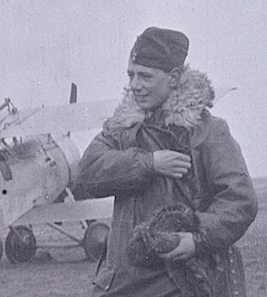| Arthur Willan Keen | |
|---|---|
 Captain Keen at Bruay with 40 Squadron some time between April and November 1917 | |
| Born | 20 March 1895 |
| Died | 2 September 1918 (aged 23) |
| Place of birth | Edgbaston, Warwickshire, England |
| Place of death | No. 5 British Red Cross (Lady Hadfield's) Hospital, Wimereux, France |
| Buried at | Terlincthun British Cemetery, Wimille, France (50°44′41″N 1°36′37″E / 50.74472°N 1.61028°ECoordinates: 50°44′41″N 1°36′37″E / 50.74472°N 1.61028°E) |
| Allegiance | United Kingdom |
| Service/branch |
British Army Royal Air Force |
| Years of service | 1915–1918 |
| Rank | Major |
| Unit |
Army Service Corps No. 70 Squadron RFC No. 40 Squadron RFC |
| Commands held | No. 40 Squadron RAF |
| Battles/wars |
World War I • Western Front |
| Awards |
Military Cross Bronze Medal of the Royal Humane Society |
Major Arthur Willan Keen MC (20 March 1895 – 2 September 1918) was a British World War I flying ace credited with fourteen aerial victories.[1]
Background and education[]
Keen was born in Edgbaston, Warwickshire, to Arthur Thomas Keen and Isabel Charlotte Eliza (née Willan). He was educated at Aldro, Dunchurch Hall and Rugby Schools before going up to Trinity College, Cambridge, in 1913 to study engineering.[1]
Military service[]
Keen left university after two years, abandoning his degree studies, in order to join the Army.[1] He was commissioned as a temporary second lieutenant in the Army Service Corps on 24 May 1915.[2]
In November 1915 he transferred to the Royal Flying Corps and attended the School of Instruction at Wantage Hall, Reading, Berkshire, before moving to Catterick, Yorkshire, for flying training. He was granted Royal Aero Club Aviator's Certificate No. 2298 on 17 January 1916, flying a Maurice Farman biplane.[1] On 15 February he was appointed a flying officer and transferred to the General List,[3] and was promoted to lieutenant on 1 June.[4]
On 17 June Lieutenant Robert Edward Andrew MacBeth crashed into the sea off Montrose. Keen, who witnessed the crash from the air, promptly landed his aircraft nearby and swam out to help MacBeth to shore. He was subsequently awarded the Bronze Medal of the Royal Humane Society.[5]
Keen was then posted to No. 70 Squadron in France, flying the Sopwith 1½ Strutter.[6] There he gained his first aerial victory by driving down a Fokker D.II out of control over Bapaume on 28 August 1916.[1] He was appointed a flight commander with the temporary rank of captain on 22 October 1916.[7] He returned to England to serve as a flying instructor between December 1916 and April 1917,[1] before being posted to No. 40 Squadron.[6] On 1 May, flying a Nieuport 17, he destroyed an Albatros D.III near Douai, to score his second win. Between then and 15 August he scored ten more victories. His award of the Military Cross was gazetted the following day.[1] Keen was then withdrawn from combat for a rest,[6] serving as an instructor at the Central Flying School from 30 November 1917.[8] On 1 April 1918 he was appointed an acting-major[9] to command a flying training squadron,[1] but soon returned to France to take command No. 40 Squadron[6] following the death of its commanding officer Roderic Dallas on 1 June.[10] Flying a S.E.5a Keen scored two more victories during his command, on 30 June and 9 August, to bring his final tally to four German fighters set on fire; three others destroyed, one of which was shared; and seven enemy aircraft driven down out of control.[1]
Keen was severely burned in a flying accident at around 21:30, 15 August at Bruay, 40 Squadron's home airfield at the time. He died of his wounds on 2 September 1918[11] in No. 5 British Red Cross (Lady Hadfield's) Hospital, Wimereux, France.[1] He is interred in Plot III. A. 17, Terlincthun British Cemetery, Wimille, France.[12]
Honours and awards[]
- Military Cross
- Temporary Captain Arthur William (sic) Keen, General List and RFC.
- "For conspicuous gallantry and devotion to duty. He has shown the greatest gallantry and skill in aerial fighting, and his daring in leading offensive patrols into favourable positions for attack has been the means of many hostile aircraft being destroyed and driven down."[13]
References[]
- Citations
- ↑ 1.0 1.1 1.2 1.3 1.4 1.5 1.6 1.7 1.8 1.9 "Arthur Willan Keen". The Aerodrome. 2015. http://www.theaerodrome.com/aces/england/keen.php. Retrieved 18 April 2015.
- ↑ "No. 29187". 8 June 1915. p. 5604. https://www.thegazette.co.uk/London/issue/29187/supplement/5604
- ↑ "No. 29495". 29 February 1916. p. 2325. https://www.thegazette.co.uk/London/issue/29495/supplement/2325
- ↑ "No. 29702". 8 August 1916. p. 7896. https://www.thegazette.co.uk/London/issue/29702/supplement/7896
- ↑ "Gallantry In Saving Life". 27 July 1916. p. 620. http://www.flightglobal.com/pdfarchive/view/1916/1916%20-%200622.html. Retrieved 18 April 2015.
- ↑ 6.0 6.1 6.2 6.3 Franks (2000), p.26.
- ↑ "No. 29825". 14 November 1916. p. 11111. https://www.thegazette.co.uk/London/issue/29825/supplement/11111
- ↑ "No. 30647". 23 April 1918. p. 4955. https://www.thegazette.co.uk/London/issue/30647/supplement/4955
- ↑ "No. 30741". 11 June 1918. p. 6935. https://www.thegazette.co.uk/London/issue/30741/page/6935
- ↑ "Roderic Stanley Dallas". The Aerodrome. 2015. http://www.theaerodrome.com/aces/australi/dallas.php. Retrieved 18 April 2015.
- ↑ AIR/76/269 - IMAGE 150 - The National Archives
- ↑ "Casualty Details: Keen, Arthur Willan". Commonwealth War Graves Commission. 2015. http://www.cwgc.org/find-war-dead/casualty/4025987/KEEN,%20ARTHUR%20WILLIAM. Retrieved 18 April 2015.
- ↑ "No. 30234". 14 August 1917. p. 8373. https://www.thegazette.co.uk/London/issue/30234/supplement/8373
- Bibliography
- Franks, Norman (2000). Nieuport Aces of World War I. London, UK: Osprey Publishing. ISBN 978-1-85532-961-4.
The original article can be found at Arthur Keen (RAF officer) and the edit history here.